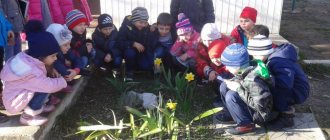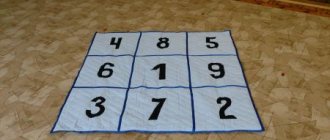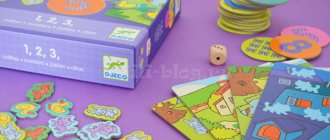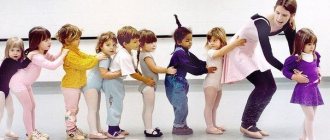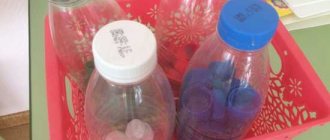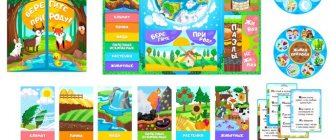Middle group. Junior preschool age. Children 4 - 5 years old
Summary of a walk in the middle group “What plants can’t do without” Goal: to develop children’s generalized ideas about showing empathy for a peer, the ability to penetrate his emotional state, encourage mutually adequate behavior, develop in children the ability to show a humane attitude towards a peer in accordance with...
Summary of the educational walk “Observing nettles” in the middle group
Goal: to introduce children to the nettle plant and its characteristics. Objectives: Educational: introduce the scientific and folk names of the plant, teach to distinguish a plant by its characteristic features. Developmental: develop thinking, curiosity, interest in native nature...
Card index of walks in the middle group for November
November
Walk 1
Observing the weather - continues to form ideas about seasonal changes; develops observation skills, teaches analysis and drawing conclusions.
Work activity: hanging bird feeders
The outdoor game “Run Quietly” - teach how to move silently.
Didactic game “What has changed?” − development of attention, coherent speech, and the ability to describe objects.
Individual work: walking on toes - to consolidate the ability to walk with coordinated movements of the arms and legs.
Walk 2
Bird watching - find out about the presence of paws in birds and their functions.
Labor activity: cleaning the area from dry twigs and pebbles
Outdoor game “Migration of Birds” - practice climbing, throwing and catching a ball with both hands.
Didactic game “Guess who called” - developing auditory attention and a sense of camaraderie.
Individual work: consolidate skills by jumping over two objects.
Walk 3
Observation of rowan - to consolidate knowledge about the benefits rowan brings to animals and birds in the cold season.
Labor activity: collecting pebbles on the site.
The outdoor game “Sparrows and the Cat” is to teach how to quickly perform movements at the teacher’s signal and run in the indicated direction.
Didactic game “Zainka” - improve children’s ability to coordinate actions with words; education of goodwill.
Individual work: game exercise “Get into the Basket” - develop accuracy and eye.
Walk 4
Observing the work of a driver - continue to form children’s understanding of the work of a driver; cultivate interest and respect for the work of adults.
Labor activity: collecting pebbles on the site.
The outdoor game “We are drivers” - continue to develop children’s motor activity; encourage the desire to reflect knowledge about work in play activities
adults.
Didactic game “Find the mistake” - develop auditory attention; learn to pronounce polysyllabic words clearly.
Individual work: Promote the development of motor skills.
polysyllabic words loudly
Walk 5
Observation of a spruce tree - to strengthen children’s skills in finding familiar trees based on one or two signs; introduce the characteristics of spruce that make it easy to distinguish it from other trees.
Labor activity: Collecting small garbage (twigs, pebbles) in buckets.
Outdoor game “Find your house” - exercise running and the ability to quickly find your house (hoop).
Didactic game “Say the Word” - to develop auditory attention; learn to pronounce polysyllabic words clearly.
Individual work: game exercise “Whose link will be most likely to gather - exercise the ability to form a circle, crawl on all fours.
Walk 6
Observing the work of a postman - to form ideas about the work of a postman; to cultivate interest and respect for the work of adults.
Labor activity: collecting waste on the site in a certain place.
The outdoor game “Leaf Fall” is to teach how to run without bumping into each other.
Didactic game “Does it happen or not?” - develop logical thinking, the ability to notice inconsistencies in plots.
Individual work: Development of movements.
Walk 7
Monitoring the work of the janitor - continue to monitor the work of the janitor; promote speech development by enriching vocabulary; cultivate interest and respect for the work of a janitor;
Labor activity: collecting waste from the site to a certain place.
The outdoor game “Birds and Rain” is to develop the ability to interact with game partners.
Didactic game “Where can I do what?” - activation in speech of verbs used in a certain situation.
Individual work: improve orientation in space and time; sense of balance, rhythm, eye.
Walk 8
Bird watching - enrich knowledge about bird life in late autumn.
Labor activity: Collecting waste from the site to a certain place.
The outdoor game “Birds and the Rain” teaches how to navigate the playground and run in different directions.
Didactic game “Which, which, which?” - learn to select definitions that correspond to a given example or phenomenon; activate previously learned words.
Individual work: learn to run in a circle and stop at a signal.
Walk 9
Watching a magpie is to expand your understanding of the birds that fly to the kindergarten site.
Labor activity: collective work collecting fallen leaves.
The outdoor game “Run Quietly” - teach how to move silently.
Didactic game “Finish the sentence” - learn to complete sentences with a word of the opposite meaning.
Individual work: strengthen the ability to jump from one circle to another.
Walk 10
Observation of rowan - to introduce the characteristic features of rowan, by which it can be distinguished from other trees.
Labor activity: collecting leaves on the site.
The outdoor game “Owl” is to teach children to act quickly on a signal from the teacher.
Didactic game “Who has who?” - consolidate knowledge of animals and their cubs.
Individual work: Walking with side steps.
Walk 11
Watching a magpie enriches your understanding of the natural world and attracts you to active mental operations.
Labor activity: instruct one subgroup of children to clear the paths of snow and leaves, and the second to collect garbage on the site.
Outdoor game “Pigeons and Sparrows” - practice running, walking, bending your head forward.
Didactic game “Find out whose leaf” - teach to recognize plants by leaf (name a plant by leaf and find it in nature).
Individual work: strengthen the ability to jump on two legs from one circle to another.
Walk 12
Observing the autumn rain - continue to form ideas about seasonal changes in nature (the sky is overcast, it became cloudy, a light autumn rain began to fall).
Labor activity: collecting fallen leaves on the site.
The outdoor game “Jump Higher” is to teach how to act quickly on a signal.
Didactic game “Who, (what) flies?” Goal: To consolidate knowledge about animals, insects and birds.
Individual work: game exercise “Brave Guys” - practice fast running, develop agility.
Walk 13
Observation of autumn leaves - to show the variety of colors of golden autumn.
Labor activity: raking fallen leaves.
Outdoor game “Hit the Target” - learn to throw a ball at a target, develop accuracy.
Didactic game: “Who can name the most actions?” Goal: Select verbs denoting actions.
Individual work: game exercise “Understand Me” - teach how to create an image with body movements.
Walk 14
Observing frost and the first frosts forms the idea of frost as one state of water.
Work activity: Construction of a snow bed
The outdoor game “Paints” is to teach children to remember the color of paint, run quickly at the teacher’s signal, and be attentive.
Didactic game “You can - you can’t” - clarify and consolidate the rules of behavior in public places.
Individual work: development of basic physical movements
Walk 15
Observing ice is to form an idea of the state of water in the environment.
Labor activity: sweeping the path leading to the site.
Outdoor game “Walk Silently” - learn to move in accordance with the text, quickly change directions of movement
Didactic game “Explain why?” — train children in the correct selection of words, teach them to understand cause-and-effect relationships between skills; consolidate the ability to construct complex sentences and develop coherent speech.
Individual work: game exercise “On a narrow path” - learn to step from circle to circle.
Walk 16
Observation of the phenomena of the first frosts - to form the premises of logical conclusions - to associate the freezing of water in puddles with cold weather.
Labor activity: picking rowan berries on the site.
The outdoor game “Catch a Flower” is to develop the ability to jump in place as high as possible.
Didactic game “How is it possible?” - exercise children in the correct selection of words, teach them to choose boring words; develop coherent speech.
Individual work: exercise with a ball.
Walk 17
Observing the bushes on the site - to give an idea of the main parts of the bush, to cultivate a caring attitude towards the plant world. ""
Labor activity: sweeping paths, collecting garbage.
Outdoor game “Fishing Rod” - teach how to jump rope
Didactic game: “What first, what then” - to consolidate children’s knowledge about age-related changes in people of different sexes; develop coherent speech and attention.
Individual work: exercises with the ball: hit the ball on the ground and catch it with both hands.
Walk 18
Observing the work of a postman - to form an idea of the work of a postman, to cultivate interest and respect for the work of adults.
Labor activity: collecting waste on the site in a certain place.
Outdoor game “Falling Leaves” - teach how to run without bumping into each other.
Didactic game “Professions” - teach children to recognize a profession by description; improve knowledge about the profession of adults.
Individual work: development of basic physical movements.
Walk 19
Watching birds while feeding - instills a desire to take care of birds; develop knowledge about the habits of birds; cultivate a love for nature.
Work activity: feeding birds
The outdoor game “From bump to bump” is to develop children’s ability to jump on two legs while moving forward.
Didactic game “Find such a piece of paper” - teach children to find a piece of paper based on a model. Fix the name of the color, wood.
Individual work: jumping around and jumping out of a circle made of leaves.
Walk 20
Observation of the roadway - introduce the roadway - highway; give an idea of the rules of the road.
Work activity: cleaning up waste on site
The outdoor game "Dashing - catching up" - learn to coordinate your actions with the actions of your comrades.
Didactic game: “ Who am I?” - learn to name a plant, develop memory, attention
Individual work: improve hoop rolling skills in any direction.
Walk 21
Observing a cat is to consolidate the idea of the characteristic features of a cat.
Labor activity: collecting waste on site.
Outdoor game: Cat and Mouse" - teach how to run easily, without bumping into each other, and how to navigate.
Didactic game: “Come up with a sentence” - consolidate the ability to make sentences with a given word.
Individual work: consolidate skills in jumping on two legs while moving forward.
Methodical manual “Observation Diary”
| Author: Bondarenko Tatyana Nikolaevna, senior teacher, first qualification category MBDOU TsRR - d/s "Buratino" Kogalym |
Kindergarten is the first link in the system of continuous environmental education, so it is no coincidence that teachers are faced with the task of forming the foundations of a culture of rational environmental management among preschoolers.
Vegetable garden and flower garden are used to develop children’s skills in caring for plants, getting to know the main vegetable crops, and their importance in our diet.
In this case, children should be guided by the structural features of plants, the period of growth and development and their needs. The Observation Diary will help us with this Photo 4
Goal: To introduce children to the life of plants; teach how to keep a diary of observation of plant development.
Tasks
To give an idea of growing plants from seeds, of the dependence of their growth on the presence of moisture, light, and heat.
Learn to observe changes in plant development, analyze, and draw conclusions about certain patterns and relationships.
Develop cognitive interest; ability to analyze and synthesize, to self-control.
Continue to improve the labor skills of children; develop hard work.
Reinforce knowledge about the structure of plants.
Cultivate an interest in plants, gain experience in an attentive and caring attitude towards growing plants.
Description of the manual
Made from fabric, paper
Complies with methodological, sanitary and hygienic requirements
Used with children of all ages
Designed for observing plants (growth, development, care)
Used for carrying out work assignments and independent activities
Content
Plant shape, cards (plant development, methods of care).
Using the manual
Observation is a purposeful, systematic perception of objects and phenomena of the surrounding world.
- Accumulation of knowledge about plant growth and development
- Comparison, the observed state of an object with what was before
- Determining the condition of the plant (the need for watering), or restoring a picture of the whole (whether the tomatoes are ripe by color)
- Development of intelligence and observation skills
- Improving the processes of analysis, comparison, and inference
- Observations when children are highly mentally active, makes them think, look for answers to questions, develop curiosity
- Establishing a connection between this observation and the previous one
Work
Work in nature is of particular importance for the all-round development of children.
Preschoolers master skills as they follow plants and learn what conditions are necessary for growth and development. With pleasure, children learn to loosen and weed the garden, water vegetables, and watch with great interest the growth and development of plants, noting their observations in the observation calendar.
The manual attracts children to participate in all types of work on caring for plants, growing them, and fosters independence.
It is important that children are not just excited about the prospect of growing delicious vegetables. The manual helps to understand the need for systematic plant care. At the same time, children should be guided by the structural features of plants, the period of growth and development and their needs.
Children receive tasks that require careful monitoring of the condition of the plant.
Use of benefits by age
Junior groups
- a surprise moment when getting acquainted with plants
- developing the ability to distinguish certain vegetables by appearance
Middle groups
- organizing observations of plant growth and development with children
- identification of characteristic features (size, color, shape, parts)
- gaming techniques
- work assignments
- comparison of objects
Senior groups
- conducting long-term observations of plant growth and development
- independent conclusions and conclusions
- visual aid (pattern and sequence of phases, stages of development)
- when using comparison techniques, when making observations
- children's verbal reports of observation results
Preparatory groups
- for children to demonstrate greater independence
- establishing various connections
- identify similar features common to a whole group of objects
- to compare views
- making your own nature calendar
A consciously correct attitude towards nature is built on a sensory perception of nature, an emotional attitude towards it and knowledge about the characteristics of life, growth and development of individual living beings. The predominant visual-effective and visual-figurative forms of thinking in preschool childhood ensure the assimilation of only specially selected and age-appropriate information about nature. The criteria for selecting natural materials are their visual presentation and the possibility of inclusion in practical activities.
There were 8 votes for this work.
Voting ended on April 13, 2014 at 11:00 p.m. Thanks everyone for participating!
Share
